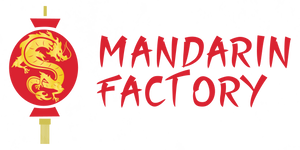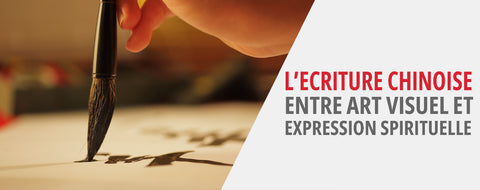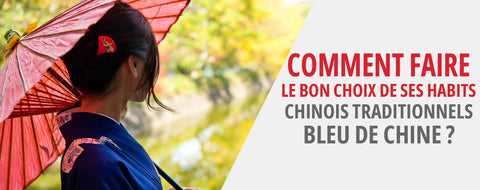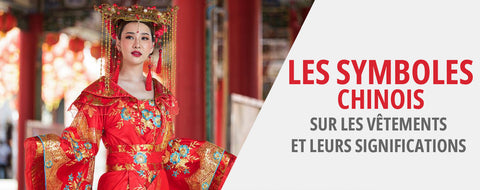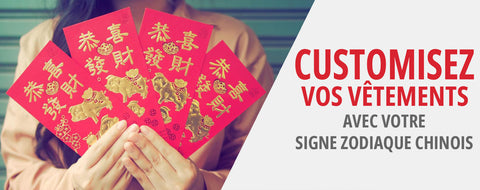
15 Chinese Bonal holders
of reading - words
China, as well as many other oriental cultures, is deeply rooted in oriental philosophy, symbolism playing a very big role in current Chinese culture, especially in the form of Feng Shui.
An important feature of Feng Shui is the use of Chinese strain holders and decorations to strengthen the harmony of your home with its environment, which improves positive energy while protecting it from bad luck.
As we are going to see through the 15 most popular buckmen of Chinese culture, good luck Chinese symbols take many forms. These symbols of the strain holder can also be used with specific elements to strengthen the various Feng Shui applications.
1) Dzi pearls

The Dzi pearls do not actually come from China but from Tibet. The Tibetan word Dzi is reflected in "shine" or "radiance" and in China, the Dzi pearls are also known as 天珠, literally translated by "pearl of the sky".
Generally made of agate carved with unique patterns, DZI pearls are also popular in Chinese Feng Shui practices as a dungeon holder. DZI stones are supposed to be effective not only to repel negative energy but also to store positive energy for their owner's chance.
DZI stones can be presented in different forms and patterns: circles, stripes, wave patterns, etc. They are commonly worn in the form of bracelets, or necklaces.
2) Chinese coins Bed carrier

You can easily distinguish the old Chinese pieces with their square hole in the middle. The round shape of the piece symbolizes the sky, while the square opening represents the earth.
The faces of the parts are generally written with four characters around the four sides of the square hole. This is the Yang side of the room. On the other side, the Yin side, there are up to two characters.
There are different ways to use these pieces as a lucky holder, generally by linking three pieces with a string or a red colored ribbon which is a coach door in China. It is believed that coins necklaces attract the financial luck.
3) laughing Buddha
One of the most common chewing holders in Chinese Feng Shui is the laughing Buddha or Buddha of happiness. This lucky holder symbolizes good fortune, prosperity, fertility, health and wealth.
The laughter Buddha is based on the story of a Buddhist monk who lived in 10th century China. This monk was rather eccentric and did not correspond to the typical characteristics of serenity and peace of a Buddhist monk, but he was always happy with a loving heart, so that he was loved by many. This monk was then considered to be the reincarnation of Gautama Buddha, And we now think that it symbolizes joy, laughter and happiness.
As a lucky charm, the laughing Buddha can be placed anywhere in the house, except in the bathroom or the toilet. However, it is generally placed in the living room or any other place in your home or your business where there is money.
4) Chinese luck cat
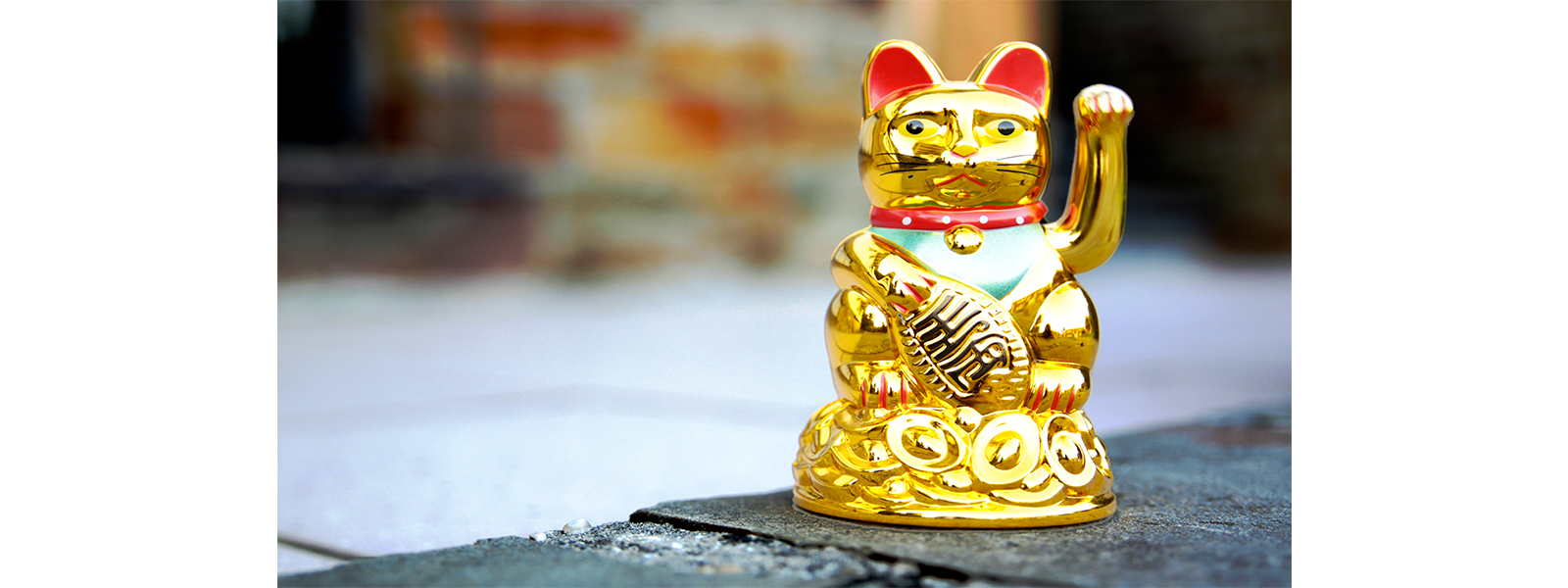
The lucky cat is based on the Japanese maneki-Neko. It’s a very common lucky charm in Feng Shui. The different colors of the cat can symbolize different things, and the fact that the cat lifts its paw on the left or right also changes symbolism.
If the cat lifts its left leg, it generally symbolizes a male cat which attracts wealth, fortune and professional success in business. You can therefore place it in your office or in the area where you usually work to improve your success.
If, on the other hand, the cat lifts the right leg, it is then a female cat which symbolizes prosperity, fertility and family happiness, as well as good health.
5) Large Chinese fortune ship

The fortune ship is also a very important lucky charm in Chinese Feng Shui. As its name suggests, it is a decoration in the shape of a ship, forms and various sizes. They generally transport precious stones and mini treasures to symbolize wealth and are very popular placed in houses and businesses.
It is believed that the fortune boat attracts wealth and good fortune. For a correct feng shui, the boat generally has sails that take the wind fully to symbolize the fact of advancing towards a better future.
There are makeshift ships entirely built with precious stones and even gold, and others that are built of real wood and silk fabric, such as an authentic ship.
6) Three -legged frog
The three-legged frog carries happiness, also called Jin Chanou or Chan Chu is also a very popular and very powerful Chinese feng. It is believed that it attracts and protects your fortune, while protecting you, you and your family, against bad luck.
The three -legged frog symbolizes the circulation of money, and Feng Shui dictates that this statue should not be placed in front of your main door. It should not be placed in your kitchen and toilets or bathroom either.
Current practice consists in placing the statue of the three -legged frog in the main entrance, while another statue next to it has its back turned at the entrance. This configuration is supposed to protect the flow of money that goes outside the house or business.
7) Amethyst crystal tree

In Chinese Feng Shui, we think that crystals contain a positive healing energy, and many people use them as concentration objects in their meditation practice.
In this case, amethyst crystals are arranged as a tree (with a resin or plastic tree branch) and are supposed to have healing properties to calm the mind. They are also considered a lucky charm for wealth and prosperity. The amethyst crystal shaft is supposed to improve memory while maintaining calm and can also help fight insomnia. He therefore holds the same functions as Dreaming catches To hunt bad spirits and help you sleep better.
There are also crystal trees made from other materials such as agate, citrine, pink quartz, and others.
8. Dragon Turtle
The dragon and the turtle are the symbols of protection, wisdom and nobility in Chinese culture. These are two of the four celestial animals (dragon, tiger, phoenix and turtle).
The dragon turtle, as its name suggests, has the body of a turtle but the head of a dragon, and it is believed that it symbolizes good health, longevity, power, courage and success. A dragon turtle statue is supposed to protect its owner from betrayal in companies and promote healthy harmony at home and at the workplace.
There are several types of dragons turtles statues used as a lucky charm, including three of the most important:
- Dragon turtle carrying a pagoda (the wen chang pagoda) on its back. It is a lucky charm for academic success
- Dragon turtle with a baby (or a couple of babies) sitting on his shell. It is believed that it improves family fertility and harmony
- Dragon Turtle seated on coins and gold ingots, as you may have guessed, symbolizes financial fortune
9) PI XIU
Pi Xiu also known as Pi Yao, Tian Lu, Bai Jie or Bin Xie, is a mythical Chinese chimera resembling a winged lion with elements of dragons. As a lucky charm in Feng Shui, the Pi Xiu statues are supposed to protect their owner from evil spirits and negative energy, thus preventing bad luck.
The Pi Xiu like to eat gold, jewelry, silver and water. We therefore think that they are enriched on all sides for their owner. It is believed that the Pi Xiu is a very loyal and obedient mythological animal, which makes it a favorite as lucky charm for personal protection. You can find Pi Xiu strain holders in different forms, such as keychain, bracelets or even statues.
10) Chi linen

Chi linen is another mythological chimera of ancient China, a creature with a dragon head but with a horse body. In addition, Chi Lin has the scales of a carp fish. Chi linen is also often called the dragon horse or sometimes Chinese unicorn.
Chi linen is supposed to provide protection to its owner, and also improve the health and wealth of the latter. In addition, he is also known to be a protector against various relationship problems in order to promote a harmonious household. However, it is mainly associated with the chance of fertility. If you want to learn more about this creature and many others Click here.
As a lucky charm, you can place Chi Lin sculpture near the main entrance to your home or workplace or in your living room. It can also arise in various other forms such as embroidery, a statue, a keychain, amulets, etc. There are also many different materials, finishes and sizes.
11) Chinese guardian lion
The Chinese guardian lion or the FU dog is another Chinese mythological creature. Traditionally, they are placed in front of the imperial palaces, government offices in ancient China, and also temples.
Nowadays, Fu dogs are considered a symbol of the wealth and social status of a family, and they are therefore often placed in front of large houses in China and Asia.
In general, the statues of the imperial guardian lion are exhibited as a couple, the female holding a lion cub under her left leg, symbolizing maternal protection, and the male holding a globe under his right leg, meaning the protection of his domain (the House).
12) Lucky Bambou Feng Shui

The lucky bamboo, also called Lucky Bambou, is a very important plant in Feng Shui and we think it brings a positive and peaceful energy in the house where it is. Bamboo is a flexible plant which is also hollow inside, and in Chinese philosophy, this symbolizes the flexibility and open -mindedness of the individual.
The Lucky Bambou can be placed inside the house, or you can also grow real bamboo plants in your garden. There are also various accessories made from bamboo stems which we think they have the same effect.
The number of stems also plays an important role in using the Lucky Bambou. Three stems, for example, are supposed to bring three kinds of luck: wealth, longevity and happiness. Seven stems, on the other hand, symbolize health, while eight stems bring luck to fertility, because the word "eight" in mandarin is very similar to the word used to "grow".
13) Symbol of double happiness

The Chinese double happiness symbol is essentially made up of the word (XI) which is written twice side by side so that two of its features are united.
The meaning of this symbol is quite literal: double dose of happiness for its owner, and it is often used as decoration during parties and celebrations (for example, the Chinese New Year, the birthday parties, the birth of a child, etc.)
The sign of double happiness was first used as a wedding decoration, a prayer symbol so that the newlyweds are happy and their marriage is durable. However, over the years, he has made his way to other Chinese festivities.
14) Chinese phoenix

He is one of the four guardians of China (Dragon, Turtle, Phoenix and Tigre), the Phoenix reigns over all the other birds of China.
The male phoenixs are called Feng, while females are called Huang. However, the distinction between the sexes is no longer typically made today, and the Phoenix is therefore often called Fenghuang, a female entity associating with the Dragon, which is generally a male entity.
As a lucky charm, the sculptures of the phoenix represent justice, obedience and fidelity, and are often used as a lucky charm for those who know bad luck, because it is believed that it is capable of making reversals in bad circumstances.
15) Koï carp

Koi is called 鲤鱼, li yu, or literally translated by "carpet fish" in China. There are many applications at this chance door. For example, a carp statue placed on a design office is supposed to provide academic success.
A common practice is to place 8 coaches of carp around the work office, because 8 is the Chinese figure of wealth and prosperity. It is also believed that some carp statues placed in the bedroom bring happiness in a wedding.
